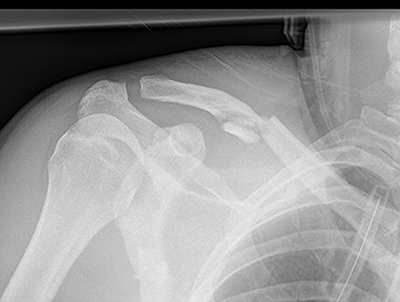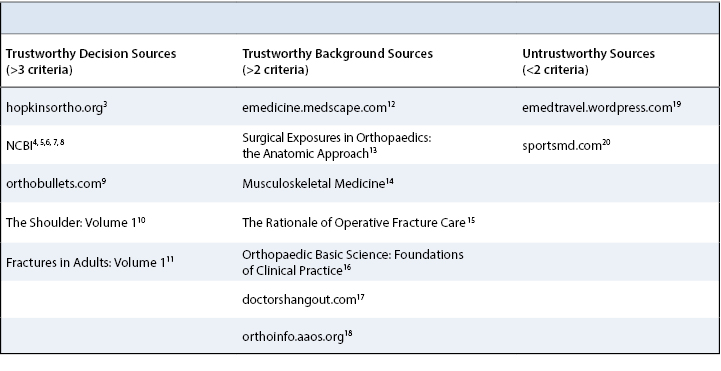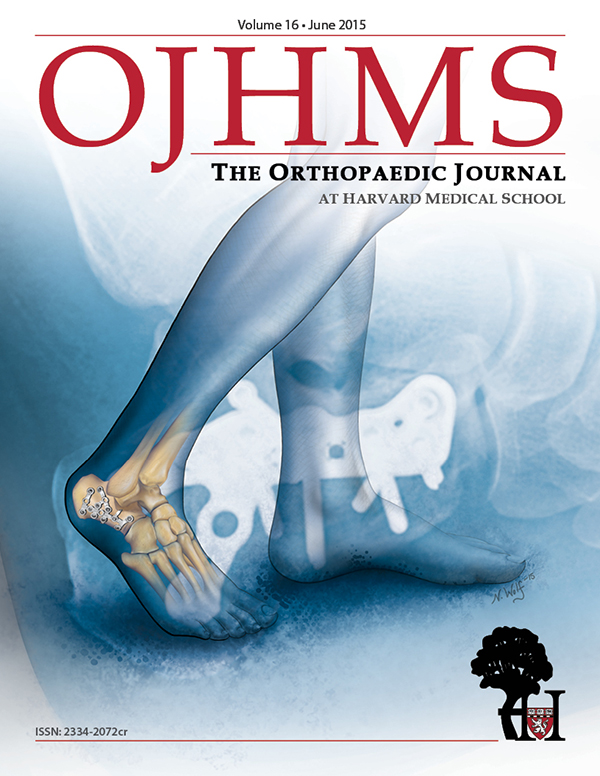Patient Perception of Trustworthy Sources for Injury Research
Elizabeth J. Bennett, Shannon E. Hogan, Nicholas H. Page, Mark S. Vrahas, MD
Disclosure Information©2015 by The Orthopaedic Journal at Harvard Medical School
BACKGROUND The advent of accessible online health information has increased the frequency with which patients research their diagnoses and treatment options. Understanding how patients determine trustworthy information and where to find such information is crucial to physicians as they adapt to the new dynamic in the patient-physician relationship. This study was designed to investigate how undergraduate students, acting as potential patients faced with an orthopaedic injury, research their injuries and how that research influences their treatment decisions.
METHODS A panel of researchers (three undergraduate students) were presented with a profile of a patient with a fractured clavicle. They were instructed to research the fracture as though they were the patient in order to determine a preferred treatment. The on-line sources utilized were initially sorted into the following categories: trustworthy background sources, trustworthy decision sources, or untrustworthy sources. Findings and the rationale behind their choice of treatment were presented to a panel of orthopedists who assisted in evaluating the students’ decision-making process.
RESULTS Most of the research yielded what was considered trustworthy background sources, which included websites written for the lay audience. Trustworthy decision sources ultimately included scholarly sources and textbooks. Untrustworthy sources predominantly consisted of blogs or sources that demonstrated clear bias.
CONCLUSION It is important for physicians to understand patients’ perceptions of the sources they read and the information they obtain about their diagnoses. What may be considered layman sources may be more trustworthy than young adult patients might have previously believed. Physicians should acknowledge the pre-existing information a patient might have and be prepared to address the discrepancy between professional opinion and the patient’s research.
LEVEL OF EVIDENCE Level V
Patients are becoming increasingly involved in researching treatment options for their orthopaedic diagnoses. As patients utilize various resources to supplement their knowledge of their condition, the patient-physician relationship has evolved such that patients may give considerable weight to the information from external sources. Up to 79% of orthopedic patients have access to the Internet, the majority of which uses this means to research their medical conditions and diagnoses.1 Because of its availability and patient’s use of health information websites, it may be beneficial for physicians to learn what types of medical sources patients are using to educate themselves, as not all sources offer the same quality of information.2
Patients can find information about their diagnoses by performing a web-based search online (i.e. “Google search”), in textbooks, in academic journals, and through word of mouth. After researching their conditions, but prior to consultation with a physician, patients begin to formulate a decision for treatment based on resources they deem trustworthy. The physicians’ goals are to understand how to better communicate with and help their patients make informed decisions regarding their treatment. Thus, the objective of our study was to examine how patients conduct research about their orthopaedic diagnoses, the sources they use, and how these sources affect their decisions.
A panel of orthopedic physicians presented a panel of researchers (three undergraduate students) with a profile of a patient with a clavicle fracture (Figure 1) The theoretical patient was a 20 year old male who fell while practicing ballet. Additional information included his symptoms: pain and swelling, but neuro and vascular intact, and additional characteristics: healthy college student who is interested in medicine. Subjects based their research on this information. They were instructed to research this fracture from the perspective of a patient and decide how they would want to be treated. Consulting medical professionals with orthopaedic expertise was not allowed. All other avenues of research including books, general web-based searches, as well as scientific databases were allowed. All sources were archived in real time and categorized to document if the information/source was used to develop a treatment algorithm. Criteria for what was considered a trustworthy sources were:
A. No obvious or potential bias
B. Scholarly or educational
C. From a well-known or reputable institution
D. Concrete evidence or references
Based on these criteria, sources were divided into three categories:
1) Trustworthy Decision Sources: Sources used for both background information and to make an ultimate decision (met at least 3 criteria)
2) Trustworthy Background Sources: Sources used only to elucidate the background information (met at least 2 criteria)
3) Untrustworthy Sources: Sources used for neither background information nor to make a decision (met less than 2 criteria)

The fracture was researched using trustworthy sources (as described above) and a treatment algorithm was determined based on this research. The research and treatment algorithm was then presented to a panel of orthopaedic surgeons. The chosen sources were discussed with the surgeons so that they might better understand the thought process and research of a potential patient.
Research was presented to the panel (Table 1). The researchers reviewed a total of 14 sources. Several sources came from peer-reviewed journals or sites, including NCBI, orthobullets.com, hopkinsortho.org, orthoinfo.aaos.org, and emedicine.medscape.org. Six of the sources were textbooks; the other eight were online sources. When placed into the three categories of trustworthiness, seven of these were considered trustworthy background sources, two were considered untrustworthy, and five were considered trustworthy enough to inform a decision for treatment. In general, the panel of researchers agreed with the treatment choices picked by the researchers and that textbooks are a trustworthy source to use. However, they disagreed with some the criteria for a trustworthy decision source. Their opinion was that the general, broader layman’s websites are trustworthy decision sources. They also considered the scholarly sources used to be less trustworthy than the researchers had previously thought.21
The criteria used to differentiate a trustworthy or untrustworthy source stemmed from previous academic experience that resulted in the perception that scholarly sources may be more credible than what may be considered layman’s sources (i.e. Wikipedia and WebMD). Well-known sources, based on name recognition within the general population4, 5, 6, 7, 8, 12 were considered to be trustworthy. Therefore, the students based their research on the sources that fit those criteria and based treatment decisions on the information from those sources deemed as trustworthy.
In contrast, the panel of physicians stated that they valued the layman’s websites more and the scholarly sources less. The physicians explained that layman’s websites were more similar to textbooks, as both were a consolidation of information amassed from a large quantity and variety of resources. Their argument was that the authors of these sites22, 23 have likely utilized multiple sources24 and drawn conclusions based on information from several sources they deem trustworthy. Therefore, to our orthopaedic surgeon panel, the information in these sources represented the most understandable and complete overview to allow patients to understand their orthopaedic problem. Of note, the researchers initially rejected these websites for anything other than background information because of their broad-based approach to a given question or topic. While some of the sites are indeed basic, physicians suggested that often that is all that is necessary. For example, Medscape is a website that offers thorough yet straightforward and accurate descriptions of treatment options. This website was originally thought to be too broad and elementary, but the panel of orthopaedists found it to be a good example of a patient-friendly and trustworthy website.21
In contrast, the physicians noted that some of the scholarly journal articles were too specific and not indicative of typical or successful outcomes due to small sample sizes. For example, much of the literature cited by the researchers indicated that the use of a “figure 8 brace” was the best option. However, during discussion with the physicians, it was learned that while this particular brace is theoretically promising, its well-repute is based on studies of very specific cases and small sample sizes.21 Uninformed orthopedic trauma patients may not recognize these issues, and could be misled to choose inappropriate or less than optimal treatment options.
There are several limitations to this study that should be addressed. As undergraduate students, the panel of researchers was not representative of the population at large. Though limited by their instructions from the panel of physicians that prohibited seeking advice from any orthopedic professional, access to relevant textbooks was much simpler than would be found in the general population. The study had a very small sample size with three researchers acting as one patient which limits the general applicability of our results. No validated objective metric was utilized to determine the “trustworthiness” of sources nor was interobserver reliability (on the part of the students or physicians) assessed. Furthermore, the appropriateness of the researcher’s treatment choice was the opinion of three orthopaedic surgeons. Additionally only one orthopaedic condition was examined. All these factors contribute to the difficulty in extrapolating these findings to broader populations.
However, as this study sought to mimic a young adult’s research on clavicle fractures from a patient’s standpoint, it shed light on the sources a patient might use to learn about their injury. Based upon the discussion with a panel of orthopaedic surgeons it was shown that there is a tendency for young adults to trust scholarly sources, but that broader sources are typically more pertinent and provide sufficient information for patients to make informed decisions. Due to the limitations of this study, we propose that future studies include larger sample sizes, a broader demographic, and examine information for disciplines outside of orthopaedic trauma.
We thank Michael Weaver, MD, Colin Heinle, MD for their analysis of our treatment decision and for participating in this study. We also thank Suzanne Morrison, MPH, Robert Lucas, and Jordan Morgan for the opportunity to participate in this study, and for their input. Supported by the Harvard Medical School Orthopedic Trauma Initiative.
The authors should be commended on their work to better elucidate internet sources that young patients may utilize when researching an orthopaedic condition. While there are methodologic shortcomings, some of which are addressed in the discussion section, the authors demonstrate that various websites offer differing levels of information about clavicle fractures and conclude that a provider’s understanding of these internet sources may be helpful during the physician-patient interaction.
A goal of OJHMS is to promote research endeavors within the Harvard orthopaedic community and to support our young researchers as they develop the skills, knowledge and most importantly the passion to seek out answers. We hope that this project as well as their internship with the Harvard Orthopaedic Trauma Initiative sparks a lifetime of “answering questions”.
John Y. Kwon, MD








